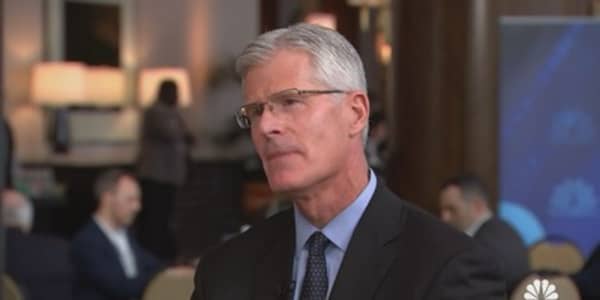The power of the North American energy industry is that it transcends borders, and while it was interconnected way before NAFTA, it is becoming even more so.
The ties are deep rooted. In the early 1900s, primitive power lines sent electricity crackling across the border between Texas and Mexico. Canada has long provided the U.S. hydroelectric power, and all three countries now send oil, refined fuels and natural gas back and forth across the northern and southern U.S. borders on a daily basis.
With trade the hot topic in Washington and now for all three members of NAFTA, the fallout from the renegotiation of the North America Free Trade Agreement and the U.S. proposals about taxing goods at the border can't help but be an important topic when the global energy industry meets in Houston this week.
In fact, Canadian Prime Minister Justin Trudeau will deliver a keynote address on Thursday, which he tweeted would be about innovation and renewable energy. CERAWeek by IHS Markit runs Monday through Friday and participants include energy ministers from Russia and Saudi Arabia, as well as CEOs from major oil companies, like Exxon Mobil, BP, Chevron and Total.
"I expect to hear a great deal at CERAWeek from Prime Minister Trudeau and industry leaders about the importance and mutual benefit from the large cross-border energy [integration]. Whatever the eventual outcome of the NAFTA debate, they're not going to want to lose benefits," said Daniel Yergin, vice chairman of IHS.
The Trump administration promises to be a strong supporter of energy, removing regulatory hurdles for the industry and encouraging more U.S. drilling. Just last week former Texas Gov. Rick Perry was approved to be Energy Secretary. Perry has spoken positively about North American integration in the past, and until recently he was on the board of Energy Transfer Partners, which is building pipelines to take natural gas to Mexico.
But the administration has also been critical of Mexico for what it claims are unfair trade practices and weak immigration controls.
So even though the industry is intertwined, the future course for North American energy is murky.
Guaranteed to be discussed at CERAWeek is the proposal from House Republicans to tax imports into the United States at a rate of 20 percent. The so-called border-adjustment tax is a major revenue generator for the House corporate tax reform plan. It is bound to generate as much debate in the energy industry gathering as it has in other affected industries, such as retail.
The prospects are for additional gas supply only to continue to increase, and right now we see over the next five years, at least, relatively flat prices for natural gas globally, so the question then becomes, Where does American natural gas fit in?Carlos Pascualsenior vice president of IHS Markit
Critics already say it would drive up both oil and gasoline prices. But proponents, among them big industrial companies, say the dollar would adjust by rising sharply and neutralizing some of the impact of higher prices.
Conceivably, under the proposal, a barrel of oil from Canada could be taxed as it enters the United States, but the gasoline it is made into would not be taxed when it is sent to Mexico. Likewise, a barrel of U.S. crude would not be taxed as it enters Canada, but the gasoline that comes back down to New England could be taxed.
The North American energy interconnections are complex and more established between the United States and Canada, which is the largest crude supplier to the United States and also a net exporter of electricity from connections that run along the border in numerous locations. Canada exports natural gas to the United States, and U.S. natural gas is sold in Canada.
But the connections to Mexico are also growing, especially since the country embarked on a reform program to overhaul its energy industry and bring in new investment. It has also been aggressively planning new power generation. Mexico was importing about 4.2 billion cubic feet of U.S. natural gas per day in August, according to the U.S. Energy Department, and analysts say it could get to 5 billion in the near future.
U.S. sales of gas to Mexico are also helping depressed U.S. natural gas prices from sinking even lower, analysts say. Gas pipeline exports to Mexico from the United States doubled since 2009. According to Citigroup, new cross-border pipeline capacity of 7 billion cubic feet is expected to come online by 2020, on top of the current 6 billion to 7 billion cubic feet.
"The growing energy integration of North America is very beneficial to all three countries," said Yergin. "U.S. natural gas producers get additional markets, while Mexican consumers get lower-priced electricity generated with that gas. Canadians get markets for their oil, reducing U.S. reliance on Venezuelan oil, while American workers in manufacturing benefit from big equipment markets to the north."
Mexico also recently put out bids for offshore exploration, and Exxon Mobil and Chevron were among the companies receiving awards. "It will give them an opportunity to bring international technology and capital in to develop Mexico's deep water. Pemex never could have developed that," said Carlos Pascual, senior vice president of IHS Markit. Pascual has served as the U.S. State Department's special envoy for energy and coordinator for international energy affairs. He was also a former ambassador to Mexico.
José Antonio González Anaya, director general of Pemex, will be a speaker at CERAWeek. Jaime Francisco Hernández Martínez, CEO of Comisión Federal de Electricidad, is also participating.
"The prospects are for additional gas supply only to continue to increase, and right now we see over the next five years, at least, relatively flat prices for natural gas globally, so the question then becomes, Where does American natural gas fit in?" Pascual said. One solution is exporting it to Mexico, the largest buyer of U.S. natural gas.
He said Mexico will also open up its unconventional drilling opportunities, holding its first round of bidding for unconventional oil and gas later this year.
"In the United States, there's been a huge benefit in the sale of natural gas to Mexico and also in the renewable-energy sector. Many of these companies buy GE equipment, for example. GE is a massive player here, particularly in wind turbines, so there's been a very significant boost to American commercial interests as a result of the development of natural gas and the power sector," Pascual said.
The U.S. oil relationship with Canada, too, can only deepen when the Keystone XL pipeline is built. President Donald Trump waved on that controversial project shortly after his inauguration, and last week the White House said the TransCanada pipeline would be exempted from the new requirement that pipelines be built with U.S. steel.
The Keystone would bring 800,000 barrels a day from Alberta to Steele City, Nebraska, before it heads to the Gulf Coast.
"This integration is not only beneficial from an economic point of view but also from a development point of view, which was one of the reasons it was encouraged in the first place," said Yergin.





